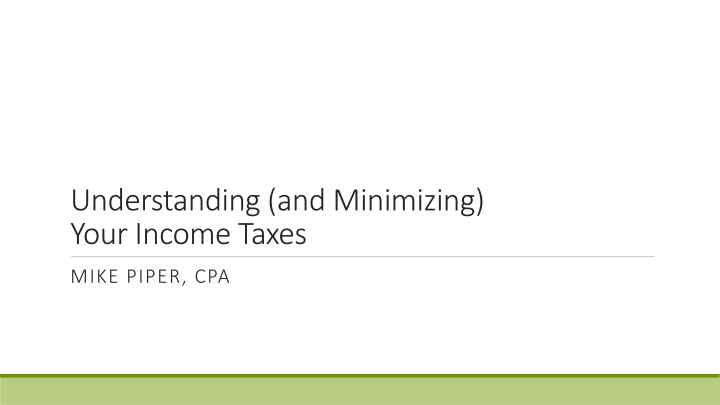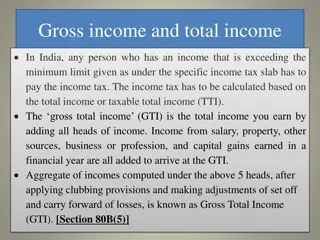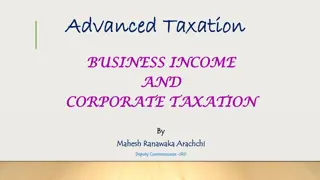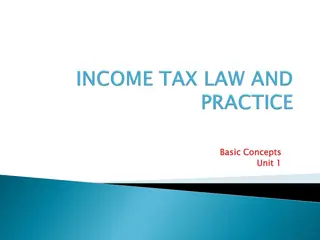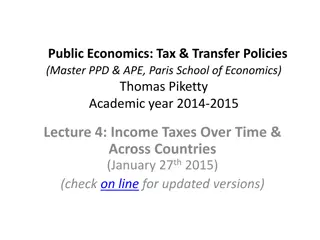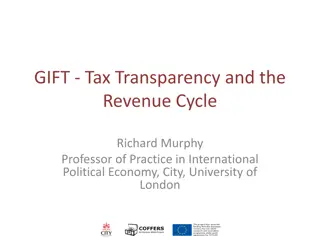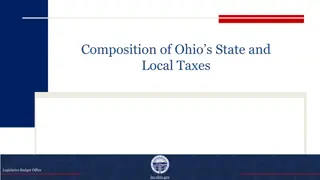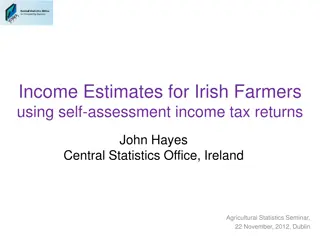Maximizing Income Tax Savings
Cut down on your tax bill by understanding the nuances of taxable income, deductions versus credits, and how to calculate your taxable income effectively across different sources of income like wages, dividends, and self-employment earnings. Learn about tax brackets, deductions for contributions like HSAs, and credits such as child tax credits to optimize your tax situation.
Download Presentation

Please find below an Image/Link to download the presentation.
The content on the website is provided AS IS for your information and personal use only. It may not be sold, licensed, or shared on other websites without obtaining consent from the author.If you encounter any issues during the download, it is possible that the publisher has removed the file from their server.
You are allowed to download the files provided on this website for personal or commercial use, subject to the condition that they are used lawfully. All files are the property of their respective owners.
The content on the website is provided AS IS for your information and personal use only. It may not be sold, licensed, or shared on other websites without obtaining consent from the author.
E N D
Presentation Transcript
Understanding (and Minimizing) Your Income Taxes MIKE PIPER, CPA
Single Married Filing Jointly Taxable Income Tax Bracket Taxable Income Tax Bracket $0 - $9,525 10% $0 - $19,050 10% $9,525 - $38,700 12% $19,050 - $77,400 12% $38,700 - $82,500 22% $77,400 - $165,000 22% $82,500 - $157,500 24% $165,000 - $315,000 24% $157,500 - $200,000 32% $315,000 - $400,000 32% $200,000 - $500,000 35% $400,000 - $600,000 35% $500,000+ 37% $600,000+ 37%
Deductions vs. Credits Deductions vs. Credits Deductions reduce your taxable income. Example: Deduction for HSA contributions Tax savings depend on tax bracket $2,000 deduction in 35% bracket = $700 tax savings
Deductions vs. Credits Deductions vs. Credits Credits reduce your tax. Example: Child tax credit $2,000 credit = $2,000 of tax savings
Calculating Taxable Income Calculating Taxable Income Gross Income - Above the line deductions Adjusted Gross Income - Standard or Itemized Deductions Taxable Income
Calculating Taxable Income Calculating Taxable Income Salary/Wages Interest Dividends Capital gains Self-employment earnings Gross Income - Above the line deductions Adjusted Gross Income - Standard or Itemized Deductions Taxable Income
Calculating Taxable Income Calculating Taxable Income SEP/SIMPLE IRA Solo 401(k) HSA self-employment tax Self-employed health insurance premiums Student loan interest Gross Income - Above the line deductions Adjusted Gross Income - Standard or Itemized Deductions Taxable Income
Calculating Taxable Income Calculating Taxable Income Gross Income - Above the line deductions Adjusted Gross Income - Standard or Itemized Deductions Taxable Income
Calculating Taxable Income Calculating Taxable Income $12,000 if Single $24,000 if MFJ Slightly higher if you re Gross Income - Above the line deductions Adjusted Gross Income blind or 65+ - Standard or Itemized Deductions Taxable Income
Calculating Taxable Income Calculating Taxable Income Home mortgage interest Medical expenses (in excess 7.5% AGI) Charitable contributions State/local taxes (now limited to $10k) Gross Income - Above the line deductions Adjusted Gross Income - Standard orItemized Deductions Taxable Income
Tax Tax- -Efficient Investing Efficient Investing Max out contributions to retirement accounts every year. How to minimize costs in taxable brokerage accounts?
Taxation of Taxable Brokerage Accounts Taxation of Taxable Brokerage Accounts Interest: taxed as ordinary income Dividends: 0%, 15%, or 20% tax rate Short-term capital gains: taxed as ordinary income. Long-term capital gains: 0%, 15%, or 20% tax rate. 3.8% net investment income tax if MAGI exceeds $200k ($250k if married filing jointly)
Tax Tax- -Efficient Investing in Taxable Accounts Efficient Investing in Taxable Accounts Look for mutual funds with low portfolio turnover Asset location Tax-loss harvesting
Tax Tax- -Efficient Investing: Low Turnover Funds Efficient Investing: Low Turnover Funds Low turnover = fewer transactions within the fund s portfolio Results in fewer capital gain distributions (and more are LT rather than ST) Usually index funds or ETFs have lowest turnover
Tax Tax- -Efficient Investing: Asset Location Efficient Investing: Asset Location Asset location: which assets in which accounts? Overall principle: put assets with highest tax costs in retirement accounts
Tax Tax- -Efficient Investing: Asset Location Efficient Investing: Asset Location Actively managed, high-turnover funds High-yield ( junk ) bonds REITs Intermediate-term bonds US stocks International stocks Short-term, lower-yielding bonds (especially Treasuries) Tax-exempt muni bonds
Tax Tax- -Efficient Investing: Tax Efficient Investing: Tax- -Loss Harvesting Loss Harvesting Look for shares with value less than your basis. Sell those shares, so you can claim a loss (offset CGs or up to $3,000 of ordinary income) Buy a replacement so you don t have to change allocation Be careful of wash sale rules. (Won t get to claim the loss.)
Tax Tax- -Efficient Investing: Tax Efficient Investing: Tax- -Loss Harvesting Loss Harvesting Wash sale occurs when you sell something for a loss and buy something substantially identical within 30 days before or after the sale. Example: sell 100 shares of Apple at a loss on April 1st Wash sale if you bought shares March 2nd May 1st
Tax Tax- -Efficient Investing: Tax Efficient Investing: Tax- -Loss Harvesting Loss Harvesting Substantially identical not explicitly defined in tax code Wash sale just postpones ability to claim loss. Can have a partial wash sale (e.g., sold 100 shares and bought 50 replacement shares during wash sale window) Purchases don t have to be in same account to trigger a wash sale. (Purchase by a spouse or in a retirement account can trigger.)
Entity Selection Entity Selection 3 options for single-owner business Sole proprietorship (or LLC taxed as such) S-corporation (or LLC taxed as such) C-corporation (or LLC taxed as such)
Entity Selection Entity Selection 3 options for multiple-owner business Partnership (or LLC taxed as such) S-corporation (or LLC taxed as such) C-corporation (or LLC taxed as such)
Entity Selection: Entity Selection: Sole Proprietorships and Partnerships Sole Proprietorships and Partnerships Sole proprietorships and partnerships are pass through businesses. Business doesn t pay income tax. Owners pay tax on profit at ordinary income tax rates. Also subject to self-employment tax Employer and employee halves of SS and Medicare taxes (15.3% up to $128,400. 2.9% beyond that)
Entity Selection: S Entity Selection: S- -Corporations Corporations Pass-through businesses: corporation doesn t pay income tax. Owners pay tax on profit at ordinary income tax rates. Profit is not subject to self-employment tax.
Entity Selection: S Entity Selection: S- -Corporations Corporations Must pay owner-employees a reasonable amount of compensation before there can be any profit. Compensation is subject to SS and Medicare taxes. Only get any savings once there s enough income for sizable profit after paying reasonable compensation
Entity Selection: Entity Selection: C C- -Corporations Corporations Corporation itself pays tax on profits (flat 21% rate now) When profit is distributed to shareholders (dividend), it s taxed again (0%, 15%, 20%) Also subject to 3.8% net investment income tax if MAGI exceeds $200k ($250k if married filing jointly)
Entity Selection: Entity Selection: C C- -Corporations Corporations Overall effect: double taxation C-corp taxation is not usually advantageous. (Still true with 2018 tax changes.)
Entity Selection: Entity Selection: Through Business Income Deduction for Pass Deduction for Pass- -Through Business Income Deduction for income from pass-through businesses Sole proprietorships Partnerships S-corporations Not C-corporations Amount of deduction: 20% of pass-through profit Limited to 20% of your taxable income (excluding CGs)
Entity Selection: Entity Selection: Through Business Income Deduction for Pass Deduction for Pass- -Through Business Income Phaseout for specified service businesses Specified service business includes any business in the field of health.
Entity Selection: Entity Selection: Through Business Income Deduction for Pass Deduction for Pass- -Through Business Income Specified service businesses is: Any business in fields of health, law, accounting, actuarial science, performing arts, consulting, athletics, financial services, brokerage services Any business where principal asset is reputation or skill of one or more owner or employee Any business which involves investment management or dealing in securities
Entity Selection: Entity Selection: Through Business Income Deduction for Pass Deduction for Pass- -Through Business Income 2018 phaseout range for specified service businesses is taxable income of: $157,500 - $207,500 if single $315,000 - $415,000 if MFJ
Entity Selection: Entity Selection: Through Business Income Deduction for Pass Deduction for Pass- -Through Business Income Another limitation kicks in over same phaseout range. Deduction limited to greater of: 50% of wages paid (to all employees), or 25% of wages, plus 2.5% of basis in qualified property (basically, depreciable property)
Entity Selection: Entity Selection: Through Business Income Deduction for Pass Deduction for Pass- -Through Business Income Overall impact: If you are below phaseout range, sole proprietorship/partnership now more advantageous relative to S-corp, because S-corp wages don t count as pass-through income If you are in phaseout range, now have an incentive to increase wages (either to employees or to yourself as S- corp employee)
Understanding (and Minimizing) Your Income Taxes MIKE PIPER, CPA
